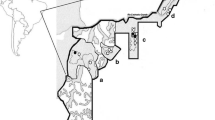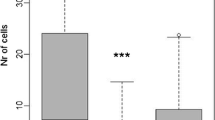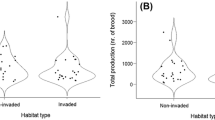Abstract
The study of the social organization of ants may help to understand why some species are able to persist in natural forests after fragmentation and anthropogenic disturbances. The Neotropical ant Gnamptogenys bisulca has shown to be a biological indicator of habitat quality in Andean montane forests and we proposed to explain this characteristic by investigating its social structure and the spatial distribution of colonies at fine scale. In eight 100 m2 plots located in four forests in the western Colombian Andes, the position of G. bisulca colonies was recorded for spatial distribution and their social composition described: ergatoid females were found in most of the nests, isolated or together with normal queens. As ergatoids and queens were dissected to examine their reproductive status, it appeared that apparent polygyny represented, in fact, effective monogyny, with other potential reproductive females being unmated or inhibited. In the few cases of mixed colonies, a queen was always at the head of the colony. Local spatial distribution was random and did not fit the hypothesis of nesting by fission, as generally observed in the case of the presence of ergatoids. However, the social structure was significantly different according to the site, the most preserved forest showing no or rare ergatoids (but queens) compared to the other sites. Our results indicated that the presence of ergatoids in G. bisulca may help colonies to adapt to slightly disturbed habitat contexts.



Similar content being viewed by others
References
Abadía JC, Bermúdez C, Lozano-Zambrano FH, Chacón P (2010) Hormigas cazadoras en un paisaje subandino de Colombia: riqueza, composición y especies indicadoras. Rev Col Entomol 36:127–134
Amor F, Ortega PK, Jowers MJ, Cerdá X, Billen J, Lenoir A, Boulay R (2011) The evolution of worker-queen polymorphism in Cataglyphis ants: interplay between individual- and colony-level selections. Behav Ecol Sociobiol 65:1473–1482
Anderson KE, Linksvayer TA, Smith CR (2008) The causes and consequences of genetic caste determination in ants (Hymenoptera: Formicidae). Myrmecol News 11:119–132
Armbrecht I, Perfecto I, Vandermeer J (2004) Enigmatic biodiversity correlations: ant diversity responds to diverse resources. Science 304:284–286
Belgade P, Mateus AR, Keller RA (2011) Evolution and molecular mechanisms of adaptive developmental plasticity. Mol Ecol 20:1347–1363
Bernstein RA, Gobbel M (1979) Partitioning of space in communities of ants. J Anim Ecol 48:931–942
Blatrix R, Jaisson P (2000) Optional gamergates in the queenright ponerine ant Gnamptogenys striatula. Mayr. Insect Soc 47:193–197
Bourke AFG, Franks NR (1995) Social evolution in ants. Princeton University Press, New Jersey
Chacón de Ulloa P, Abadía JC (2014) Dos décadas de estudio de la diversidad de hormigas en Colombia. Rev Acad Colomb Cien Exac Fís y Nat 38:250–260
Clark PJ, Evans FC (1954) Distance to nearest neighbor as a measure of spatial relationships in populations. Ecol Soc Am 35:445–453
Crozier RH, Pamilo P (1996) Evolution of social insect colonies sex allocation and kin selection. Oxford University Press, Oxford
Cultid-Medina CA, Escobar F (2016) Assessing the ecological response of dung beetles in an agricultural landscape using number of individuals and biomass in diversity measures. Environ Entomol 45:310–319
Donoso DA, Ramón G (2009) Composition of a high diversity leaf litter ant community (Hymenoptera: Formicidae) from an Ecuadorian pre-montane rainforest. Ann Société Entomol de France 45:487–499
Ellis S, Procter D, Buckham-Bonnett P, Robinson E (2017) Inferring polydomy: a review of functional, spatial and genetic methods for identifying colony boundaries. Insectes Soc 64:19–37
Fletcher DJ, Blum MS (1981) Pheromonal control of dealation and oogenesis in virgin queen fire ants. Science 212:73–75
García-Martínez MA, Quiroz-Robledo LN, Valenzuela-González JE (2015) Nuevos registros de hormigas (Hymenoptera: Formicidae) para México y los estados de Oaxaca y Veracruz. Dugesiana 22:107–109
Giraud T, Blatrix R, Poteaux C, Solignac M, Jaisson P (2001) High genetic relatedness among nestmate queens in the polygynous ponerine ant Gnamptogenys striatula in Brazil. Beha Ecol Sociobiol 49:128–134
Gobin B, Peeters C, Billen J (1998) Colony reproduction and arboreal life in the Ponerine ant Gnamptogenys menadensis (Hymenoptera: Formicidae). Neth J Zool 48:53–63
Gobin B, Billen J, Peeters C (2001) Dominance interactions regulate mating in Gnamptogenys menadensis. Ethology 107:495–508
Hammer Ø, Harper DAT, Ryan PD (2001) PAST: paleontological statistics software package for education and data analysis. Palaeontologia Electronica 4(1):9
Heinze J (1998) Intercastes, intermorphs and ergatoid queens: who is who in ant reproduction? Insectes Soc 45:113–124
Heinze J (2008) Social plasticity: ecology, genetics, and the structure of ant societies. In: Korb J, Heinze J (eds) Ecology of social evolution. Springer, Berlin, pp 129–150
Herrera-Rangel J, Jiménez-Carmona E, Armbrecht I (2015) Monitoring the diversity of hunting ants (Hymenoptera: Formicidae) on a fragmented and restored andean landscape. Environ Entomol 44:1287–1298
Jiménez-Carmona E (2015) Respuesta ecológica de las hormigas del suelo a la restauración de un paisaje andino. Dissertation, Universidad del Valle, Cali, Colombia
Jiménez-Carmona E, Domínguez-Haydar Y, Henao N, Zabala G, Escobar S, Armbrecht I, Chacón de Ulloa P (2015) Las hormigas en el monitoreo de la restauración ecológica. In: Aguilar-Garavito M, Ramírez W (eds) Monitoreo a procesos de restauración ecológica aplicado a ecosistemas terrestres, 1st edn. Instituto de Investigación de Recursos Biológicos Alexander von Humboldt, Bogotá, pp 108–118
Johnson RA (2010) Independent colony founding by ergatoid queens in the ant genus Pogonomyrmex: queen foraging provides an alternative to dependent colony founding. Insectes Soc 57:169–176
Johnson R, Overson R (2018) Population and colony structure and morphometrics in the queen dimorphic little black ant, Monomorium sp. AZ-02, with a review of queen phenotypes in the genus Monomorium. PLoS One 12:1–17
Kaptein N, Billen J, Gobin B (2003) Larval begging for food enhances reproductive options in the ponerine ant Gnamptogenys striatula. Anim Behav 69:293–299
Kaspari M (1996) Litter ant patchiness at the 1-m2 scale: disturbance dynamics in three neotropical forests. Oecologia 107:265–273
Kempf WW, Brown W (1968) Report on some neotropical ant studies. Papéis Avulsos de Zoologia 22:89–102
Lachaud J-P, Cadena A, Schatz B, Pérez-Lachaud G, Ibarra-Núñez G (1999) Queen dimorphism and reproductive capacity in the ponerine ant Ectatomma ruidum Roger. Oecologia 120:515–523
Lattke JE (1990) Revisión del género Gnamptogenys Roger en Venezuela (Hymenoptera: Formicidae). Acta Terramaris 2:1–47
Lattke JE (1995) Revision of the ant genus Gnamptogenys in the new world (Hymenoptera: Formicidae). J Hym Res 4:137–193
Lattke JE, Fernández F, Arias-Penna TM, Palacio EE, Mackay W, Mackay E (2008) Género Gnamptogenys Roger. In: Jiménez E, Fernández F, Arias TM, Lozano-Zambrano FH (eds) Sistemática, biogeografía y conservación de las hormigas cazadoras de Colombia, 1st edn. Instituto de Investigación de Recursos Biológicos Alexander von Humboldt, Bogotá, pp 66–100
Lenoir JC, Lachaud JP, Nettel A, Fresneau D, Poteaux C (2011) The role of microgynes in the reproductive strategy of the neotropical ant Ectatomma ruidum. Naturwissenschaften 98:347–356
Lommelen E, Johnson CA, Drijfhout FP, Billen J, Wenseleers T, Gobin B (2006) Cuticular hydrocarbons provide reliable cues of fertility in the ant Gnamptogenys striatula. J Chem Ecol 32:2023–2034
McGlynn TP (2010) Polygyny in thief ants responds to competition and nest limitation but not food resources. Insectes Soc 57:23–28
Molet M, Fisher BL, Ito F, Peeters C (2009) Shift from independent to dependent colony foundation and evolution of “multi-purpose” ergatoid queens in Mystrium ants (subfamily Amblyoponinae). Biol J Linn Soc 98:198–207
Molet M, Wheeler D, Peeters C (2012) Evolution of novel mosaic castes in ants: modularity, phenotypic plasticity, and colonial buffering. Am Nat 180:328–341
Okada Y, Plateaux L, Peeters C (2013) Morphological variability of intercastes in the ant Temnothorax nylanderi: pattern of trait expression and modularity. Insectes Soc 60:319–328
Oliveira RF, Silva RR, Souza-Campana DR, Nakano MA, Morini MS (2015) Worker morphology of the ant Gnamptogenys striatula Mayr (Formicidae, Ectatomminae) in different landscapes from the Atlantic Forest domain. Rev Brasil Entomol 59:21–27
Peeters C (1987) The reproductive division of labour in the queenless ponerine ant Rhytidoponera sp. 12. Insectes Soc 34:75–86
Peeters C (2012) Convergent evolution of wingless reproductive across all subfamilies of ants, and sporadic loss of winged queens (Hymenoptera: Formicidae). Myrmecol News 1:75–91
Peeters C, Adams RMM (2016) Uncoupling flight and reproduction in ants: evolution of ergatoid queens in two lineages of Megalomyrmex (Hymenoptera: Formicidae). J Insect Sci 16:1–5
Peeters C, Ito F (2001) Colony dispersal and the evolution of queen morphology in social Hymenoptera. Ann Rev Entomol 46:601–630
Peeters C, Molet M (2010) Colonial reproduction and life histories. In: Lach L, Parr CL, Abbott KL (eds) Ant ecology, 1st edn. Oxford University Press, New York, pp 159–176
Plateaux L (1970) Sur le polymorphisme social de la fourmi Leptothorax nylanderi (Förster). I. Morphologie et biologie compare’es des castes. Ann Sci Nat Zool Biol Anim 12:373–478
Pratt SC (1994) Ecology and behavior of Gnamptogenys horni (Formicidae: Ponerinae). Insectes Soc 41:255–262
Rosset H, Chapuisat M (2007) Alternative life-histories in a socially polymorphic ant. Evol Ecol 21:577–588
Serna F, Mackay W (2010) A descriptive morphology of the ant genus Procryptocerus (Hymenoptera: Formicidae). J Insect Sci 10:1–36
Sinclair DF (1985) On tests of spatial randomness using mean nearest neighbor distance. Ecology 66:1084–1085
Smith SR, Anderson KE, Tillberg CV, Gadau J, Suarez AV (2008) Caste determination in a polymorphic social insect: nutritional, social and genetic factors. Am Nat 172:497–507
Soares SM, Schoereder JH (2001) Ant-nest distribution in a remnant of tropical rainforest in southeastern Brazil. Insectes Soc 48:280–286
Souza DR, Fernandes TT, Nascimento JRO, Suguituru SS, Morini MSC (2012) Characterization of ant communities (Hymenoptera: Formicidae) in twigs in the leaf litter of the Atlantic rainforest and eucalyptus trees in the southeast region of Brazil. Psyche 2012:1–12
Steiner FM, Crozier RH, Schlick-Steiner BC (2010) Colony structure. In: Lach L, Parr CL, Abbott KL (eds) Ant ecology, 1st edn. Oxford University Press, New York, pp 177–193
R Core Team (2018) R: a language and environment for statistical computing. R Foundation for Statistical Computing, Vienna, Austria. http://www.R-project.org/. Accessed 27 July 2018
Weber NA (1938) The biology of the fungus-growing ants. Part 4. Additional new forms Part 5. The Attini of Bolivia. Rev de Entomol 9:154–2060
Zabala GA, Arango LM, Chacón de Ulloa P (2013) Diversidad de hormigas (Hymenoptera: Formicidae) en un paisaje cafetero de Risaralda, Colombia. Rev Colomb Entomol 39:141–149
Acknowledgements
Giovany Copete, Alexander Velez y Juan Sebastian Ramírez helped in field work. Roberto José Guerrero reviewed for morphological structures. Wilmar Torres (Graduate Biology Program office, Universidad del Valle, Cali, Colombia) helped in statistical analyses, GEAHNA ’s research group for facilities, equipment and laboratory. Photos were taken by Juan Felipe Ortega, Francisco Lopez Machado and Diana Marcela Urcuqui at the Images Laboratory from the Biology Graduate Program Department of Biology, Universidad del Valle. Helen Burnham checked for proper English. This study was financed by Universidad del Valle, Research Vicerrectory office, through the Project “Estructura del paisaje como modelador del flujo génico de dos especies de hormigas cazadoras en la zona cafetera de los andes”, code CI 71075 and by the bilateral Project Colciencias/Ecos Nord/Universidad del Valle/Université Paris 13 entitled “Estrategias de reproducción y estructuras de poblaciones en diferentes especies de insectos sociales en Colombia” Contract FP44842-672-2015.
Author information
Authors and Affiliations
Corresponding author
Electronic supplementary material
Below is the link to the electronic supplementary material.
Rights and permissions
About this article
Cite this article
Urcuqui, D.M., Herrera-Rangel, J., Poteaux, C. et al. Social structure of Gnamptogenys bisulca (Formicidae: Ectatomminae) in tropical forests. Insect. Soc. 66, 569–580 (2019). https://doi.org/10.1007/s00040-019-00716-w
Received:
Revised:
Accepted:
Published:
Issue Date:
DOI: https://doi.org/10.1007/s00040-019-00716-w




